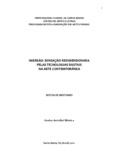| dc.creator | Silveira, Greice Antolini | |
| dc.date.accessioned | 2011-10-25 | |
| dc.date.available | 2011-10-25 | |
| dc.date.issued | 2011-03-24 | |
| dc.identifier.citation | SILVEIRA, Greice Antolini. IMMERSION: WIDENED FEELING THROUGH DIGITAL TECHNOLOGY IN CONTEMPORARY ART. 2011. 125 f. Dissertação (Mestrado em Artes) - Universidade Federal de Santa Maria, Santa Maria, 2011. | por |
| dc.identifier.uri | http://repositorio.ufsm.br/handle/1/5199 | |
| dc.description.abstract | This Master Thesis goals the comprehension of the enlargement that digital images add to the art field, specially the immersion feeling. It is thought that the feeling that the observer is inside the images is intensified by artistic experiences with digital technology, in this way it seems to be important to discuss such subject in a contemporary context, searching for some differences of the idea of immersion into images before and after digital technologies. To understand this transition from analog to digital image, that could be talks to as the production of image, considering the difference of being in front of, amid or in the image, besides explaining about the passage from observation to interaction between the art work and the interactor. Being within an ambient or not depends primarily on the comprehension of reality, so it is presented in this study discussions on reality, some questions on virtual and virtual reality Some devices are approached, so their contribution to the thinking of the feeling of immersion in artistic images relating it with current trend and getting in digital devices aside from showing some immersion levels suggested by researchers. For some detailed forthcoming the following art works will be analyzed: Osmose (2005) by Chair Davies and VRAquarium (2005) by Diana Domingues and Artecno team. Images that fullfil 360 grades from the observer sight can be found among all the Art History; some of them were made in order to cause in the spectator an immersion feeling in the presented scene. Therefore the attempt to comprehend the possible modifications that digital imaging provide to the Arts, especially the feeling of immersion, demonstrates itself as pertinent to understand how images can be presented at contemporary times. | eng |
| dc.description.sponsorship | Coordenação de Aperfeiçoamento de Pessoal de Nível Superior | |
| dc.format | application/pdf | por |
| dc.language | por | por |
| dc.publisher | Universidade Federal de Santa Maria | por |
| dc.rights | Acesso Aberto | por |
| dc.subject | Imersão | por |
| dc.subject | Realidade virtual | por |
| dc.subject | Arte contemporânea | por |
| dc.subject | Arte digital | por |
| dc.subject | Immersion | eng |
| dc.subject | Virtual reality | eng |
| dc.subject | Contemporary art | eng |
| dc.subject | Digital art | eng |
| dc.title | Imersão: sensação redimensionada pelas tecnologias digitais na arte contemporânea | por |
| dc.title.alternative | Immersion: widened feeling through digital technology in contemporary art | eng |
| dc.type | Dissertação | por |
| dc.description.resumo | Esta dissertação tem como objetivo compreender o redimensionamento que as imagens digitais dão ao campo da arte, sobretudo a sensação de imersão. Acredita-se que a sensação do observador estar na imagem intensifica-se a partir das experimentações artísticas com tecnologias digitais, de modo que é importante discutir este tema no contexto contemporâneo, buscando identificar algumas diferenças da ideia de imersão nas imagens antes e depois das tecnologias digitais. Para entender esta passagem da imagem analógica à digital discorre-se como ocorre a produção da imagem, ponderando sobre a diferença de estar diante, em meio ou na imagem, além de explanar sobre a passagem da observação à interatividade entre obra e interator. Estar ou não imerso em outro ambiente depende primeiramente da compreensão que se tem da realidade, assim também se apresentam neste estudo uma discussão acerca da realidade, algumas questões sobre o virtual e a realidade virtual. Abordam-se alguns dispositivos que contribuem para pensar a sensação de imersão em imagens artísticas, relacionando-os com propostas atuais, chegando até os dispositivos digitais, além de apresentar alguns níveis de imersão propostos por diferentes pesquisadores. Para uma aproximação mais aprofundada, analisa-se as obras Osmose (1995) de Char Davies e VRAquarium (2005), de Diana Domingues e Grupo Artecno. Imagens que compreendem 360 graus da visão do observador podem ser encontradas durante toda história da arte, de modo que, algumas vezes elas são realizadas com o intuito de causar a sensação de imersão na cena apresentada. Assim, tentar compreender as possíveis modificações que a imagem digital proporciona ao campo da arte, sobretudo a sensação de imersão, mostra-se pertinente para entender como as imagens podem ser apresentadas na contemporaneidade. | por |
| dc.contributor.advisor1 | Santos, Nara Cristina | |
| dc.contributor.advisor1Lattes | http://lattes.cnpq.br/0024977948247395 | por |
| dc.contributor.referee1 | Prado, Gilberto dos Santos | |
| dc.contributor.referee1Lattes | http://lattes.cnpq.br/6055293234902956 | por |
| dc.contributor.referee2 | Carvalho, Ana Maria Albani de | |
| dc.contributor.referee2Lattes | http://lattes.cnpq.br/8583123342049705 | por |
| dc.contributor.referee3 | Rey, Sandra Terezinha | |
| dc.contributor.referee3Lattes | http://lattes.cnpq.br/1304040199380156 | por |
| dc.creator.Lattes | http://lattes.cnpq.br/1495368284779694 | por |
| dc.publisher.country | BR | por |
| dc.publisher.department | Artes | por |
| dc.publisher.initials | UFSM | por |
| dc.publisher.program | Programa de Pós-Graduação em Artes Visuais | por |
| dc.subject.cnpq | CNPQ::LINGUISTICA, LETRAS E ARTES::ARTES | por |


